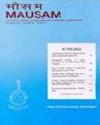基于中短期影响的印度强降雨预报
IF 0.7
4区 地球科学
Q4 METEOROLOGY & ATMOSPHERIC SCIENCES
引用次数: 0
摘要
在过去的几十年里,由于季风观测和数值模拟的重大进展,我们对季风季节强降雨的认识取得了重大进展。所有这些都使中短期(5天以内)强降雨预报更加准确,近5年(2018-2022年)强降雨预报精度比前5年提高了40%。然而,预报和预警技术的提高不足以减少对生命和财产的损失。必须扩展到灾害预报系统(灾害模型),然后扩展到影响和风险评估,与利益相关者互动,以进行基于风险的预警(RBW)和响应行动,以保护生命和生计。考虑到所有这些,印度气象部门(IMD)自2013年7月以来在气象分部级别引入了基于影响的暴雨预报(IBF),并于8月在区和城市规模引入了基于影响的暴雨预报(IBF)。2019年的中短期预报和临近预报,指出强降雨可能对不同部门产生的影响以及所需的应对行动。此后,暴雨的IBF数年发生了数次变化。目前,气象署推行的IBF包括所有四个组成部分,即(i)气象灾害、(ii)地球物理灾害、(iii)地理空间应用和(iv)社会经济情况,并利用基于网络地理信息系统的决策支持系统。在本研究中,我们回顾了印度暴雨IBF的各种方法和发展阶段。强降雨IBF的成功将加强对农业、水和电力等关键资源的管理,并支持城市和灾害管理部门等,同时减少生命和财产损失。本文章由计算机程序翻译,如有差异,请以英文原文为准。
Short to medium range impact based forecasting of heavy rainfall in India
There have been major advances in the last few decades in our understanding of heavy rainfall during monsoon season due to substantial progress in both observation and numerical modelling of monsoon. All these resulted in more accurate forecast of heavy rainfall in short to medium range, (upto five days) with 40% improvement in accuracy of heavy rainfall forecast in recent five years (2018-2022) as compared to previous five years. However, improvement of forecast and warning skill is not sufficient to minimize damage to lives and property. It is essential to extend to hazard forecast systems (hazard models) and then to impact and risk assessment with stakeholder interaction for risk based warning (RBW) and response action to protect lives and livelihoods
Considering all these, India Meteorological Department (IMD) has introduced impact based forecast (IBF) for heavy rainfall at meteorological sub-division level since July 2013 and at district and city scale in August, 2019 in its short to medium range forecasts and nowcasts indicating the likely impact of the heavy rainfall in different sectors and required response actions. Thereafter the IBF of heavy rainfall has undergone several changes over the years. Currently, the IBF being implemented by IMD includes all the four components, viz., (i) meteorological hazards, (ii) geophysical hazards, (iii) geospatial applications and (iv) socio-economic conditions and it utilises a web-GIS based decision support system (DSS). In this study we have reviewed various approaches and stages of development of IBF of heavy rainfall in India. The success of IBF of heavy rainfall will enhance the management of critical resources like agriculture, water & power and support urban and disaster management sectors among others while reducing loss of life and property.
求助全文
通过发布文献求助,成功后即可免费获取论文全文。
去求助
来源期刊

MAUSAM
地学-气象与大气科学
CiteScore
1.20
自引率
0.00%
发文量
1298
审稿时长
6-12 weeks
期刊介绍:
MAUSAM (Formerly Indian Journal of Meteorology, Hydrology & Geophysics), established in January 1950, is the quarterly research
journal brought out by the India Meteorological Department (IMD). MAUSAM is a medium for publication of original scientific
research work. MAUSAM is a premier scientific research journal published in this part of the world in the fields of Meteorology,
Hydrology & Geophysics. The four issues appear in January, April, July & October.
 求助内容:
求助内容: 应助结果提醒方式:
应助结果提醒方式:


